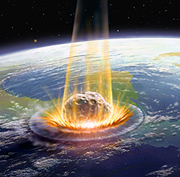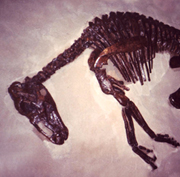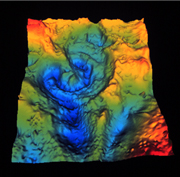What's Bad for One Species is Good for Another
 Enlargement
Enlargement
Artist's rendering of the moment of impact as seen from space. |
In the course of the Earth's history, there have been more than 20 mass extinctions in which a large portion of plant and animal life disappeared. The most recent extinction took place 65 million years ago when a meteoroid with a diameter of 10 kilometres crashed into the Earth. Debris falling into the ocean caused tidal waves, and the blast from the explosion caused hurricanes. The heat generated by the impact set off forest fires all over the surrounding continent. Large amounts of dust and vapour were thrown out into the atmosphere, blocking almost all light from the Sun. Photosynthesis decreased drastically, temperatures dropped, and the food chain was broken.

Enlargement
Climatic changes and other consequences of this colossal impact were fatal for the dinosaurs. |
Many plant and animal species, including dinosaurs, disappeared. In fact, 70% of the species perished. The crater from this impact is in Mexico. It is over 160 kilometres in diameter. This mass extinction marks the beginning of the Age of Mammals: having survived, mammals took over the ecological niches left open by the dinosaurs.
 |
| Enlargement |
| Location of the Chicxulub crater on the Yucatán Peninsula, presumed impact site of the meteorite that led to the extinction of dinosaurs. |
 |
| Enlargement |
| The crater can no longer be seen today. It is buried under a deep layer of sediments. Scientists have detected it by the gravitational anomaly it causes. |
|